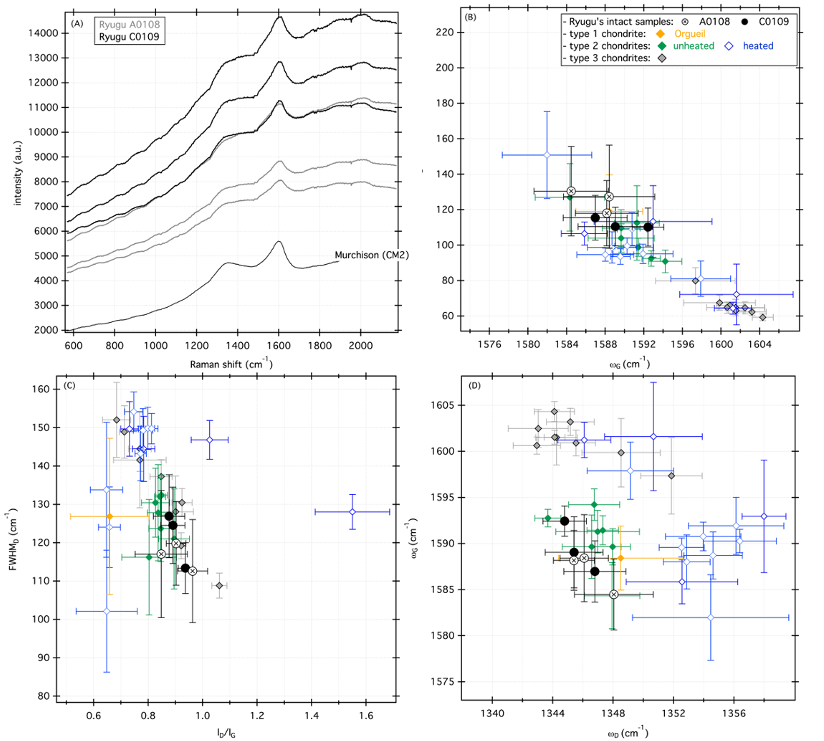Thermal history of Ryugu based on Raman and IR characterization of Hayabusa2 samples
- 1Université Grenoble Alpes, IPAG, France
- 2ENS Lyon, France
- 3The Graduate Universitu for Advanced Studies (Sokendai), Japan
- 4Hiroshima University, 1-3-1 Kagamiyama, Higashi-Hiroshima, Hiroshima 739-8526, Japan
- *A full list of authors appears at the end of the abstract
Introduction: JAXA’s Hayabusa2 asteroid sample return mission targeted the carbonaceous (C-type) asteroid 162173 Ryugu. The Hayabusa2 spacecraft collected samples from two touchdown sites on Ryugu and returned them to Earth on December 6, 2020, six years after launch. Since then, the goal of the Insoluble Organic Macromolecule Initial Analysis Team (PI: H. Yabuta) has been to elucidate the distributions and chemical characteristics of macromolecular organic materials in a C-type asteroid [1]. The degree of structural order of the polyaromatic carbonaceous matter present in extraterrestrial samples is a tracer of the thermal history they experienced (e.g., primitive chondrites: [2-5]; micrometeorites: [6-7]). To characterize Ryugu’s thermal history (long vs. short thermal heating and its extent), we thus perform Raman characterization of several intact grains and also on extracted insoluble organic matter from aggregates originating from the two collecting sites. In order to be fully confident in the obtained data and interpretation, Raman characterization was led independently by two groups in Japan and in France on distinct Ryugu particles.
Samples and methods: Raman point analyses were performed on several fragments of several intact grains from Chamber A aggregates (A0108, A0106) from the first touchdown site and six intact grains from Chamber C aggregates (C0109, C0057) from the second touchdown site. The insoluble carbonaceous residue isolated by acid treatment from the same aggregates have also been characterized and the data are currently being interpreted.
The Raman spectra were acquired with a 532 nm laser in both Japan and France. Because some Raman bands related to carbonaceous matter are dispersive, data for Ryugu particles and comparison samples have been acquired and analyzed consistently in both Japan and in France. In particular, in France, Raman measurements were performed at the Ecole Normale Supérieure de Lyon (Laboratoire de Géologie de Lyon—Terre, Planètes, Environnement) using a LabRam HR800 Raman spectrometer (Horiba Jobin-Yvon) equipped with a 600 g/mm grating. The laser was focused through a 100× objective to obtain a <2 μm spot size. The power on the sample was 0.3 mW. Each acquisition comprised six integrations of 15 s that were averaged to make the final spectrum.
Results and Discussion: The Raman data acquired in Japan and in France are fully consistent. Each acquired spectrum is characterized by a high fluorescence background and by the presence of the Raman D- (~ 1350 cm-1) and G-bands (~ 1580 cm-1), related to the presence of poorly ordered carbonaceous matter. The spectral parameters derived from the mathematical fitting of the individual spectra - band widths (FWHMD, FWHMG), band positions (ωD, ωG), and band intensity ratio (ID/IG) - are all clustering in the same area (Fig. 1).
In order to evaluate the thermal history of the Ryugu asteroid, the spectral parameters derived from Ryugu’s samples were compared with those obtained on meteorites. In a plot FWHMGvs. ωG (Fig. 1B), the Ryugu samples are clearly distinct from petrologic type 3 chondrites. In the plots FWHMDvs. ID/IG (Fig. 1C) and ωGvs. ωD (Fig. 1D), the parameters from Ryugu samples are comparable to those derived from the primitive Ivuna-type (CI) and Mighei-type (CM) carbonaceous chondrites of petrologic types 1 and 2, respectively. On the other hand, they are distinct from thermally metamorphosed CM chondrites, such as Wisconsin Range (WIS) 91600, Pecora Escarpment (PCA) 02012, and Jbilet Winselwan meteorites.
The interpretation of spectral data acquired on IOM is currently under progress. The spectral parameters are consistent with those derived from IOM extracted from primitive chondrites, as expected from the data obtained on intact particles.
These results indicate that Ryugu escaped significant long duration radiogenic thermal metamorphism as well as significant impact induced short-duration heating. This is consistent with tracers visible on IR spectra of the intact particles: presence of Mg-rich phyllosilicates and CH2/CH3 ratios comparable with primitive chondrites [8].

Acknowledgments: L.B. and E.Q. thank the French space agency CNES for its support.
References: [1] Yabuta et al. Submitted to Science – in revision [2] Bonal L. et al. (2006) GCA, 70, 1849-1863. [3] Bonal L. et al. (2016) GCA, 189, 312-337. [4] Busemann H. et al. (2007) Meteoritics & Planet. Sci. 42: 1387-1417. [5] Quirico E. et al. (2018) GCA, 241, 17-37. [6] Dobrica E. et al. (2011) Meteoritics & Planet. Sci. 46, 1363-1375. [7] Battandier M. et al. (2018) Icarus, 306, 74-93. [8] Kebukawa et al. (2022) LPSC abstract #1271.
G. D. Cody, C. Engrand, Y. Kebukawa, B. De Gregorio, L. Bonal, L. Remusat, R. Stroud, E. Quirico, L. R. Nittler, M. Hashiguchi, M. Komatsu, E. Dartois, J. Mathurin, J. Duprat, T. Okumura, Y. Takahashi, Y. Takeichi, D. Kilcoyne, S. Yamashita, A. Dazzi, A. Deniset-Besseau, S. Sandford, Z. Martins Y. Tamenori, T. Ohigashi, H. Suga, D. Wakabayashi, M. Verdier-Paoletti, S. Mostefaoui, G. Montagnac, J. Barosch, K. Kamide, M. Shigenaka, L. Bejach, S. Vitale, D. Aoki, K. Fukushima, S. Sugita, K. Yumoto, N. Sugimoto, T. Noguchi, H. Yurimoto T. Nakamura, R. Okazaki, H. Naraoka, K. Sakamoto, S. Tachibana, S. Watanabe, and Y. Tsuda
How to cite: Bonal, L., Quirico, E., Montagnac, G., Komatsu, M., and Yabuta, H. and the The Hayabusa2-initial-analysis IOM team: Thermal history of Ryugu based on Raman and IR characterization of Hayabusa2 samples, Europlanet Science Congress 2022, Granada, Spain, 18–23 Sep 2022, EPSC2022-1131, https://doi.org/10.5194/epsc2022-1131, 2022.

